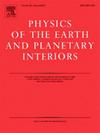Unraveling composite magnetic fabrics through tensor decomposition
IF 1.9
3区 地球科学
Q2 GEOCHEMISTRY & GEOPHYSICS
引用次数: 0
Abstract
Magnetic anisotropy plays a central role in many petrofabric and paleomagnetic studies. Anisotropy is typically represented by a second-order symmetric tensor that reflects the combined contributions from mineral populations with differing grain sizes, orientation distributions and particle scale anisotropies. Thus, the quality of geologically significant information obtained from magnetic anisotropy data depends on our ability to disentangle the complexity of these coexisting fabrics. In this study, we present a least-squares technique that can be employed in combination with additional geological or other supporting evidence to separate measured anisotropy tensors into independent contributions with distinct physical meaning. The analysis is readily adaptable and widely applicable to interpreting composite hybrid magnetic anisotropies, like those which arise from tectonic forces.
Here, we revisit published deposition experiments and anisotropy of anhysteretic remanence (AARM) measurements to demonstrate the usefulness of the tensor decomposition approach. Remanence anisotropy measurements are decomposed into idealized tensorial sub-components originating from the preferred alignment of particles parallel to the magnetic field (field-aligned fabric) and within the bedding plane (sedimentary fabric). The least-squares decomposition isolates the field-aligned fabric by subtracting the sedimentary-compaction fabric. After subtraction of the sedimentary fabric, quantitative paleofield strength and direction can be directly inferred from the field-aligned subfabric.

通过张量分解展开复合磁性织物
磁各向异性在许多岩组构和古地磁研究中起着中心作用。各向异性通常由二阶对称张量表示,该张量反映了不同粒度、取向分布和颗粒尺度各向异性的矿物种群的综合贡献。因此,从磁各向异性数据中获得的地质重要信息的质量取决于我们解开这些共存结构的复杂性的能力。在这项研究中,我们提出了一种最小二乘技术,该技术可以与额外的地质或其他支持证据相结合,将测量的各向异性张量分离为具有不同物理意义的独立贡献。该分析易于适应并广泛适用于解释复合混合磁各向异性,例如由构造力引起的磁各向异性。在这里,我们回顾了已发表的沉积实验和非滞后剩余物(AARM)测量的各向异性,以证明张量分解方法的有效性。剩磁各向异性测量被分解为理想化的张量子分量,这些张量子分量来自于平行于磁场的粒子的优选排列(场向结构)和层理平面内的粒子(沉积结构)。最小二乘分解通过减去沉积压实结构分离出场向结构。减去沉积组构后,可直接从场向亚组构中推断出定量的古场强度和方向。
本文章由计算机程序翻译,如有差异,请以英文原文为准。
求助全文
约1分钟内获得全文
求助全文
来源期刊

Physics of the Earth and Planetary Interiors
地学天文-地球化学与地球物理
CiteScore
5.00
自引率
4.30%
发文量
78
审稿时长
18.5 weeks
期刊介绍:
Launched in 1968 to fill the need for an international journal in the field of planetary physics, geodesy and geophysics, Physics of the Earth and Planetary Interiors has now grown to become important reading matter for all geophysicists. It is the only journal to be entirely devoted to the physical and chemical processes of planetary interiors.
Original research papers, review articles, short communications and book reviews are all published on a regular basis; and from time to time special issues of the journal are devoted to the publication of the proceedings of symposia and congresses which the editors feel will be of particular interest to the reader.
 求助内容:
求助内容: 应助结果提醒方式:
应助结果提醒方式:


